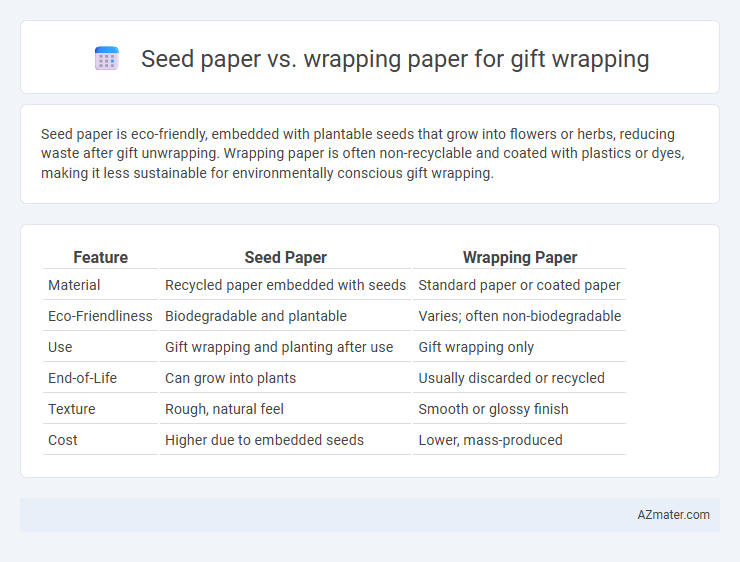Seed paper is eco-friendly, embedded with plantable seeds that grow into flowers or herbs, reducing waste after gift unwrapping. Wrapping paper is often non-recyclable and coated with plastics or dyes, making it less sustainable for environmentally conscious gift wrapping.
Table of Comparison
| Feature | Seed Paper | Wrapping Paper |
|---|---|---|
| Material | Recycled paper embedded with seeds | Standard paper or coated paper |
| Eco-Friendliness | Biodegradable and plantable | Varies; often non-biodegradable |
| Use | Gift wrapping and planting after use | Gift wrapping only |
| End-of-Life | Can grow into plants | Usually discarded or recycled |
| Texture | Rough, natural feel | Smooth or glossy finish |
| Cost | Higher due to embedded seeds | Lower, mass-produced |
Introduction to Eco-Friendly Gift Wrapping
Seed paper and wrapping paper offer distinct eco-friendly gift wrapping options, with seed paper embedded with biodegradable seeds that promote plant growth after unwrapping, reducing waste and encouraging sustainability. Wrapping paper made from recycled or sustainably sourced materials minimizes environmental impact by conserving resources and reducing landfill contributions. Choosing seed paper supports biodiversity and eco-conscious gifting, while recycled wrapping paper provides a practical, low-impact alternative for environmentally responsible celebrations.
What is Seed Paper?
Seed paper is an eco-friendly material embedded with seeds that can be planted to grow flowers, herbs, or vegetables after use. Unlike conventional wrapping paper, which typically ends up in landfills, seed paper offers a sustainable alternative that combines gifting with environmental benefits. This biodegradable paper reduces waste and promotes greenery, making it a popular choice for eco-conscious consumers.
What is Traditional Wrapping Paper?
Traditional wrapping paper is typically made from bleached or dyed materials, often coated with plastic or containing non-recyclable elements, which contribute to environmental waste. It features vibrant patterns and designs printed on smooth, glossy surfaces designed to enhance the visual appeal of gifts. Unlike seed paper, traditional wrapping paper lacks eco-friendly attributes such as biodegradability or embedded seeds for planting.
Environmental Impact: Seed Paper vs Wrapping Paper
Seed paper offers a biodegradable and eco-friendly alternative to traditional wrapping paper by embedding seeds that can grow into plants, reducing waste and promoting sustainability. In contrast, conventional wrapping paper often contains plastic coatings or metallic finishes that hinder recycling and contribute to landfill accumulation. Choosing seed paper minimizes environmental impact through natural decomposition and supports biodiversity, while typical wrapping paper adds to pollution and resource depletion.
Benefits of Using Seed Paper for Gift Wrapping
Seed paper for gift wrapping offers unique environmental benefits by being fully biodegradable and embedded with seeds that can be planted to grow flowers, herbs, or vegetables after use. This sustainable alternative reduces waste compared to traditional wrapping paper, which often ends up in landfills. Using seed paper enhances the gifting experience by adding an interactive, eco-friendly element that encourages recipients to nurture plants and support biodiversity.
Drawbacks of Traditional Wrapping Paper
Traditional wrapping paper often contains non-recyclable materials, heavy inks, and plastic coatings, contributing to environmental pollution and landfill waste. Its single-use nature leads to excessive resource consumption and limited biodegradability. In contrast, seed paper offers an eco-friendly alternative by integrating plantable seeds, promoting sustainability and reducing waste impact.
Aesthetic and Customization Options
Seed paper offers a unique, eco-friendly aesthetic with a natural texture and embedded seeds that grow into plants, enhancing gift presentation with a living element. Wrapping paper provides a wide range of vibrant colors, patterns, and finishes, allowing extensive customization to match various themes and personal styles. While seed paper emphasizes sustainability and subtle elegance, traditional wrapping paper excels in versatility and detailed design options for visually impactful gift wrapping.
Cost Comparison and Accessibility
Seed paper typically costs more than traditional wrapping paper due to its eco-friendly materials and embedded seeds, making it a premium option for gift wrapping. Wrapping paper is widely accessible and available in various price ranges, often sold in bulk at discount stores or online, which reduces its overall cost. While seed paper is less common and may require ordering from specialty retailers, wrapping paper is generally found in most retail outlets, offering greater convenience for consumers.
How to Wrap Gifts Using Seed Paper
Seed paper offers an eco-friendly alternative to traditional wrapping paper by embedding plant seeds within biodegradable material, allowing recipients to plant the paper after use. To wrap gifts using seed paper, cut the paper to size, wrap it securely around the gift, and tie it with natural twine or ribbon to enhance the rustic, sustainable aesthetic. This method not only provides a visually appealing presentation but also promotes environmental responsibility through easy planting and sustainable disposal.
Making Sustainable Choices for Gift Giving
Seed paper offers an eco-friendly alternative to traditional wrapping paper by embedding biodegradable seeds that grow into plants, reducing waste and promoting sustainability. Wrapping paper, often made from non-recyclable materials or coated with plastics, contributes to environmental pollution and landfill accumulation. Choosing seed paper for gift wrapping supports green initiatives, enhances the gifting experience with a living element, and aligns with eco-conscious values for sustainable celebrations.

Infographic: Seed paper vs Wrapping paper for Gift wrapping
 azmater.com
azmater.com